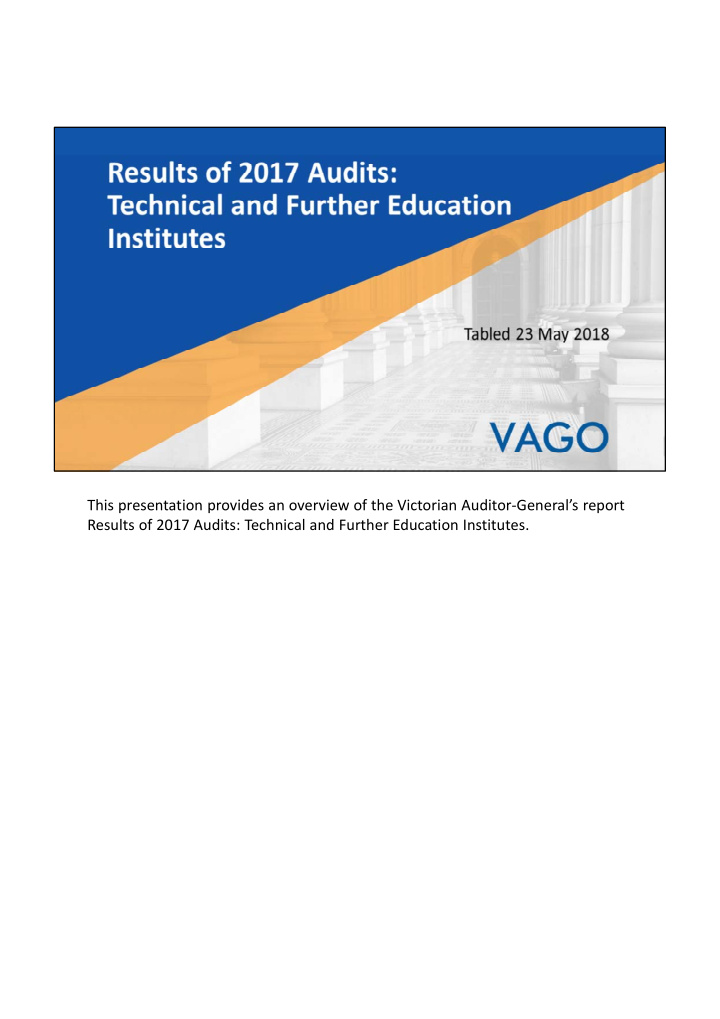



This presentation provides an overview of the Victorian Auditor ‐ General’s report Results of 2017 Audits: Technical and Further Education Institutes.
This report outlines the results and observations of our financial audits of the Technical and Further Education (TAFE) sector for the year ended 31 December 2017. We also assessed the financial results, outcomes and sustainability risks for the sector, and looked at its compliance with a 'best practice' asset valuation framework.
The TAFE sector is made up of 12 technical Institutes, and their 16 controlled entities. The sector delivers vocational education and training (VET) courses throughout Victoria. The entire VET sector is comprised of TAFEs, dual sector Universities, adult and community education agencies, and other registered training organisations (known as RTOs) ‐ all of these entities provide VET courses, however only TAFEs are covered by this report. In 2017 there were 249 614 students enrolled in TAFEs, equating to 33 per cent of enrolments in the entire VET sector throughout Victoria. In 2017, there were a number of new initiatives for the TAFE sector, including the introduction of Skills First funding.
We issued clear audit opinions on all 12 TAFEs, and 16 controlled entities. Overall, we found that the sector had good quality financial reporting processes and practices, and presented relatively accurate draft financial statements for audit in a timely manner. The sector also began to streamline the structure and content of its financial reports in 2017, which served to enhance their readability and usefulness. We commend the sector for its commitment to this initiative.
We issued clear audit opinions on the performance reports of all 12 TAFEs. There are opportunities to enhance performance reporting across the sector. We recommended that TAFEs: • Link performance indicators to their strategic objectives; and • Provide comprehensive explanations of variances between targets and the actual results.
As part of our audits, we assess whether the TAFEs had appropriate controls in place to manage the risks that their financial reports would not be complete and/or accurate. Overall, we found that internal controls at TAFEs were generally well designed and operating as intended. However, we identified 16 new control weaknesses that we rated as extreme, high or medium risk. Additionally, TAFEs have not resolved 11 issues raised through previous audits. All items should be resolved by entities in a timely manner.
This year, the TAFE sector was required to revalue its assets (mainly land, buildings and equipment) in accordance with Financial Reporting Direction 103F. At 31 December 2017, the TAFE sector held property, plant and equipment valued at $2.41 billion, an increase of about $456 million, or 23% from the prior year. This balance equates to 74.2 per cent of all assets held by the sector. We found that most TAFEs employed good practices regarding their revaluation processes. However, we also identified further opportunities for improvement.
The sector generated a net surplus of $77.5 million for the year, which represents a $34.2 million or 79 per cent increase from the prior year. The improved net result was driven partly by a 6.7 per cent increase in student enrolments. This increase generated additional fees and contestable funding. The increase in student numbers is a reversal of declining enrolments since 2012, and is partly attributable to the new Skills First model which encourages TAFEs to offer courses that are likely to lead to employment and meet industry needs.
We assess the short ‐ term health of the TAFE sector by focusing on two key indicators—the average net result ratio and the average liquidity ratio. Improvements in these ratios over the past three years reflect the increased grant and student revenue of the sector, as shown in the graphs on this slide. Overall, the sector's short ‐ term financial sustainability risks are low.
TAFEs have been increasing spending on asset renewal and replacement over the past two years to enhance their longer ‐ term sustainability. While this is a positive outcome, TAFEs will need to monitor and address their maintenance back ‐ log to ensure they are sustainable in the longer term. When compared to the Department of Education and Training guidelines, the sector has been underspending on repairs and maintenance over the past five years. DET has calculated that this underspending has resulted in a maintenance backlog of $120.8 million.
We made four recommendations to TAFEs and one to the Department of Education and Training. Three relate to asset management frameworks and two relate to performance reporting.
We have created a data dashboard, an interactive visualisation tool summarising the financial statement data for all Victorian TAFEs. You can find the dashboards on our website.
For further information, please see the full report of this audit on our website, www.audit.vic.gov.au.
Recommend
More recommend